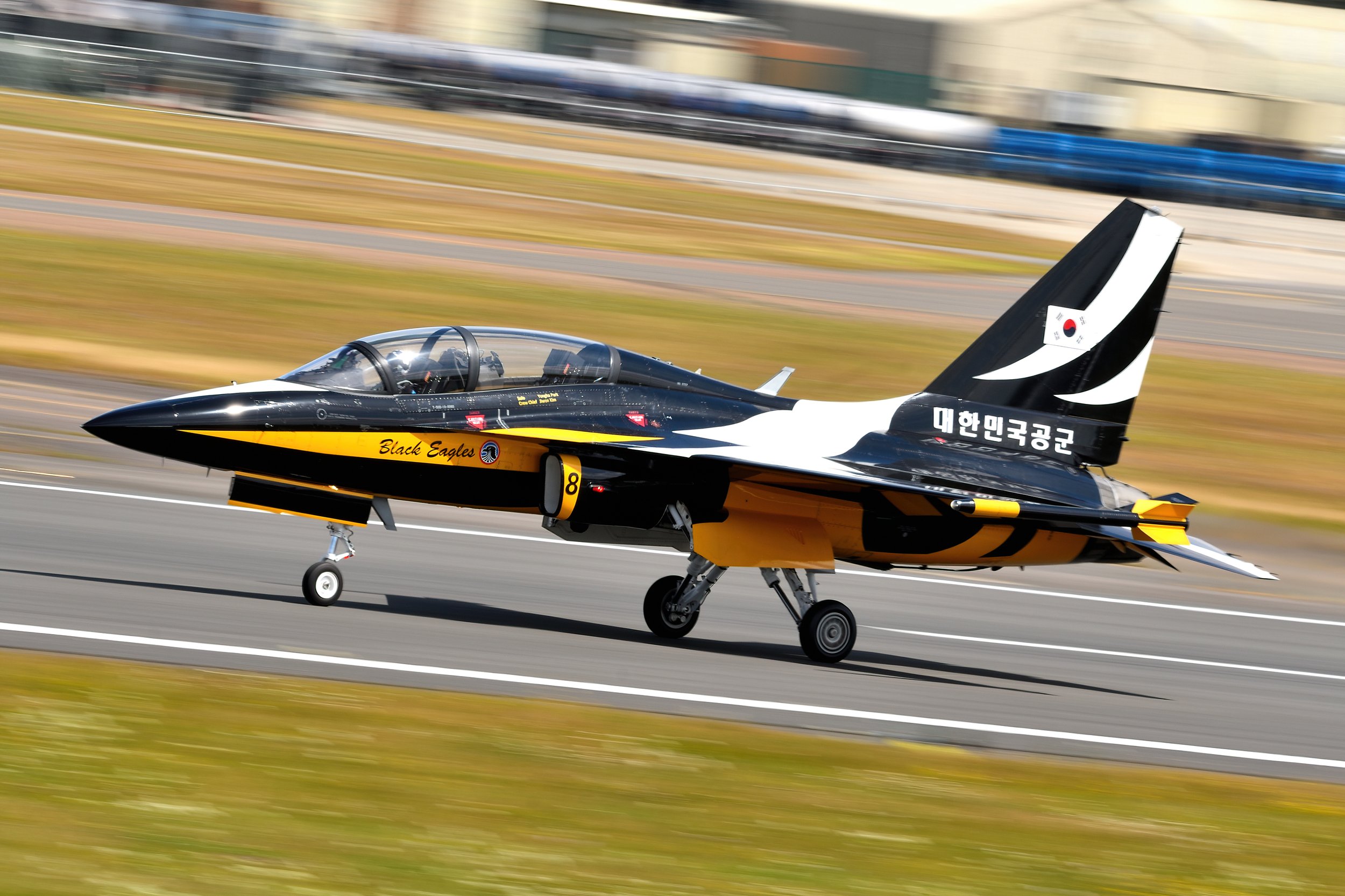
August 20 / KAI T-50 Golden Eagle first flight
First Flight 20 August 2002
KAI T-50 Golden Eagle
The KAI T-50 Golden Eagle is a family of supersonic advanced jet trainers and light combat aircraft developed by Korea Aerospace Industries (KAI) in collaboration with Lockheed Martin. The T-50 is a remarkable achievement as it was the first indigenous supersonic aircraft developed in South Korea. It is also one of the rare supersonic trainers worldwide. The T-50 project began in the late 1990s and had its maiden flight in 2002. The aircraft was put into active service with the Republic of Korea Air Force (ROKAF) in 2005.
The T-50 family of aircraft includes various aerobatic and combat variants, which include T-50B, TA-50, and FA-50. A single-seat multirole fighter variant called the F-50 was also considered, but it was later cancelled. The T-50B is an advanced trainer variant that is used by the South Korean air force's aerobatics team.
The T-50 has been used by several countries, including Iraq, Indonesia, the Philippines, Thailand, Poland, and Malaysia. Iraq ordered 24 T-50IQ training variants in 2013, which were delivered in 2016. Indonesia ordered 16 TA-50 light attack variants in 2011, and all the planes were put into service by 2014. In 2021, Indonesia ordered six more planes. The Philippines ordered 12 units of the FA-50 light fighter variant in 2014, which were delivered over the next few years. The country is now considering buying another batch of 12 planes. Thailand ordered 12 units of the T-50 advanced trainer variant (T-50TH) starting in 2015. Poland ordered 48 FA-50 aircraft in 2022, and Malaysia ordered 18 of the latest Block 20 variant in 2023.
The T-50's impressive capabilities and its flexibility in serving different roles have made it a popular choice among air forces worldwide. Its advanced features and systems, coupled with its cost-efficiency, have made it a reliable and effective aircraft for training and combat purposes.
The T-50 program was established to create a homegrown trainer aircraft that would be capable of supersonic flight and prepare pilots for the KF-16 and F-15K, replacing existing trainers such as the T-38 and A-37 that were in service with the ROKAF. The program was initiated after the South Korean government recognized the need for an advanced trainer aircraft that could match the requirements of the modern battlefield, and also reduce dependence on foreign aerospace companies.
Prior to the T-50 program, South Korean aircraft programs included the KT-1 basic trainer produced by Daewoo Aerospace (now part of KAI), and the license-manufactured KF-16. The T-50 series of aircraft, specifically the FA-50, closely resembles the KF-16 in configuration.
The mother program, code-named KTX-2, began in 1992, but due to financial constraints, the Ministry of Finance and Economy suspended the program in 1995. However, by 1999, the basic design of the aircraft was finalized, and the development of the aircraft was funded 70% by the South Korean government, 17% by KAI, and 13% by Lockheed Martin.
The T-50 Golden Eagle was formally designated in February 2000, and the T-50A designation was reserved by the U.S. military to prevent it from being inadvertently assigned to another aircraft model. The first T-50 was assembled between January 15 and September 14, 2001, with its first flight taking place in August 2002. The initial operational assessment was conducted from July 28 to August 14, 2003.
KAI and Lockheed Martin collaborated on a joint marketing program for the T-50 internationally. The ROKAF placed an order for 25 T-50s in December 2003, with deliveries scheduled between 2005 and 2009. The original T-50 aircraft were equipped with the AN/APG-67(v)4 radar from Lockheed Martin. The T-50 is powered by a GE F404 engine with Full Authority Digital Engine Control (FADEC), which is built under license by Samsung Techwin. Under the terms of the T-50/F404-102 co-production agreement, GE provides engine kits directly to Samsung Techwin, which produces designated parts and performs final engine assembly and testing.
T-50 Golden Eagle Facts
Joint Development: The T-50 Golden Eagle was jointly developed by Korea Aerospace Industries (KAI) and Lockheed Martin. This collaboration combined South Korean engineering with American aerospace technology.
Advanced Avionics: The T-50 is equipped with advanced avionics, including a digital fly-by-wire control system, which enhances its manoeuvrability and stability, making it suitable for both training and light combat roles.
Supersonic Capability: Unlike many other trainer aircraft, the T-50 is capable of supersonic flight, with a maximum speed of Mach 1.5. This allows trainees to experience high-speed flight conditions similar to those of operational fighter jets.
Combat Variants: The T-50 platform has several variants, including the TA-50 light attack aircraft and the FA-50 light combat aircraft, which are equipped with additional weapons systems and enhanced radar capabilities.
International Operators: Apart from South Korea, the T-50 and its variants have been exported to several countries, including Poland, Indonesia, Iraq, the Philippines, and Thailand, enhancing their air force training and combat capabilities.
Engine Power: The T-50 is powered by a single General Electric F404-GE-102 turbofan engine, which provides a high thrust-to-weight ratio, contributing to its agility and performance.
First Flight: The T-50 made its maiden flight on August 20, 2002. Since then, it has undergone extensive testing and development to ensure its reliability and effectiveness.
Cockpit Design: The aircraft features a glass cockpit with colour multifunction displays (MFDs) and a hands-on throttle and stick (HOTAS) system, which are similar to those found in modern fighter jets, providing trainees with a realistic training environment.
Ejection Seats: The T-50 is equipped with zero-zero ejection seats, which allow pilots to safely eject even at zero altitude and zero airspeed, enhancing pilot safety in emergency situations.
Aerial Demonstrations: The T-50 is used by the South Korean Air Force’s aerobatic team, the Black Eagles. Their performances demonstrate the aircraft’s exceptional manoeuvrability and handling characteristics, showcasing its capabilities to international audiences.




